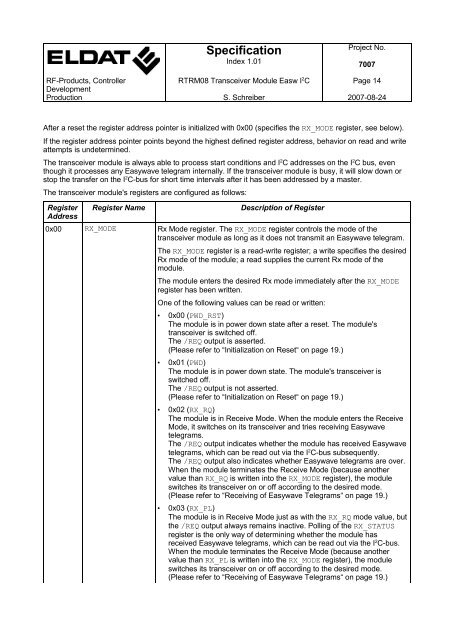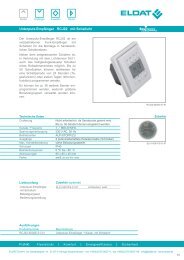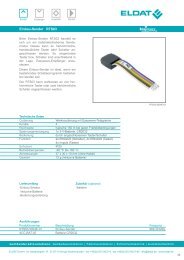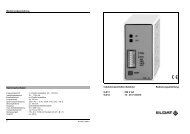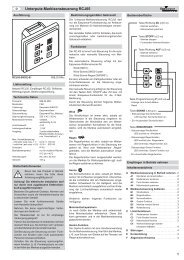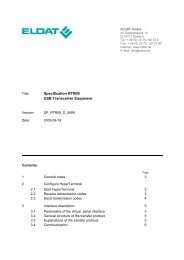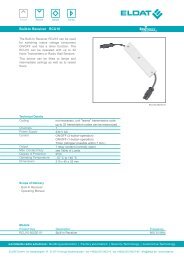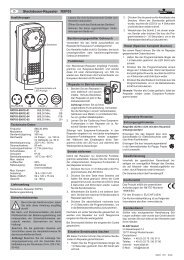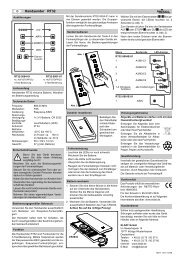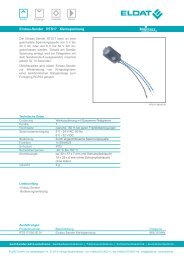Specification of RTRM08 Transceiver Module Easywave I2C - ELDAT
Specification of RTRM08 Transceiver Module Easywave I2C - ELDAT
Specification of RTRM08 Transceiver Module Easywave I2C - ELDAT
Create successful ePaper yourself
Turn your PDF publications into a flip-book with our unique Google optimized e-Paper software.
<strong>Specification</strong><br />
Index 1.01<br />
Project No.<br />
RF-Products, Controller <strong>RTRM08</strong> <strong>Transceiver</strong> <strong>Module</strong> Easw I 2 C Page 14<br />
Development<br />
Production S. Schreiber 2007-08-24<br />
After a reset the register address pointer is initialized with 0x00 (specifies the RX_MODE register, see below).<br />
If the register address pointer points beyond the highest defined register address, behavior on read and write<br />
attempts is undetermined.<br />
The transceiver module is always able to process start conditions and I 2 C addresses on the I 2 C bus, even<br />
though it processes any <strong>Easywave</strong> telegram internally. If the transceiver module is busy, it will slow down or<br />
stop the transfer on the I 2 C-bus for short time intervals after it has been addressed by a master.<br />
The transceiver module's registers are configured as follows:<br />
Register<br />
Address<br />
Register Name Description <strong>of</strong> Register<br />
0x00 RX_MODE Rx Mode register. The RX_MODE register controls the mode <strong>of</strong> the<br />
transceiver module as long as it does not transmit an <strong>Easywave</strong> telegram.<br />
7007<br />
The RX_MODE register is a read-write register; a write specifies the desired<br />
Rx mode <strong>of</strong> the module; a read supplies the current Rx mode <strong>of</strong> the<br />
module.<br />
The module enters the desired Rx mode immediately after the RX_MODE<br />
register has been written.<br />
One <strong>of</strong> the following values can be read or written:<br />
• 0x00 (PWD_RST)<br />
The module is in power down state after a reset. The module's<br />
transceiver is switched <strong>of</strong>f.<br />
The / REQ output is asserted.<br />
(Please refer to “Initialization on Reset“ on page 19.)<br />
• 0x01 (PWD)<br />
The module is in power down state. The module's transceiver is<br />
switched <strong>of</strong>f.<br />
The / REQ output is not asserted.<br />
(Please refer to “Initialization on Reset“ on page 19.)<br />
• 0x02 (RX_RQ)<br />
The module is in Receive Mode. When the module enters the Receive<br />
Mode, it switches on its transceiver and tries receiving <strong>Easywave</strong><br />
telegrams.<br />
The / REQ output indicates whether the module has received <strong>Easywave</strong><br />
telegrams, which can be read out via the I 2 C-bus subsequently.<br />
The / REQ output also indicates whether <strong>Easywave</strong> telegrams are over.<br />
When the module terminates the Receive Mode (because another<br />
value than RX_RQ is written into the RX_MODE register), the module<br />
switches its transceiver on or <strong>of</strong>f according to the desired mode.<br />
(Please refer to “Receiving <strong>of</strong> <strong>Easywave</strong> Telegrams“ on page 19.)<br />
• 0x03 (RX_PL)<br />
The module is in Receive Mode just as with the RX_RQ mode value, but<br />
the / REQ output always remains inactive. Polling <strong>of</strong> the RX_STATUS<br />
register is the only way <strong>of</strong> determining whether the module has<br />
received <strong>Easywave</strong> telegrams, which can be read out via the I 2 C-bus.<br />
When the module terminates the Receive Mode (because another<br />
value than RX_PL is written into the RX_MODE register), the module<br />
switches its transceiver on or <strong>of</strong>f according to the desired mode.<br />
(Please refer to “Receiving <strong>of</strong> <strong>Easywave</strong> Telegrams“ on page 19.)


